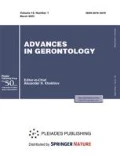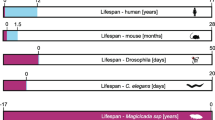Abstract
A distribution analysis of various aging patterns in the animal world provides information on the causes of differences in aging that are observed among different species, since the system reflects the evolutionary routes that resulted in the emergence of different animals. The system of different groups of animals is presented in this work as a table; the distribution of the groups that demonstrate the minimum and the maximum aging is discussed. Colonial forms are considered as a minimum and animals that have a self-destruction program (with pink salmon, which die after spawning, being the best-known example) as a maximum. It is shown that an increase in signs of aging is observed with the growth of the degree of difference from the simplest ancestor. The delayed aging of relatively simple organisms cannot serve as a direct source of means for deceleration or “cancellation” of aging for complex organisms.
Similar content being viewed by others
References
Berg, L.S., About Species and Its Subdivision, Biol. Zhurn., 1910, vol. 1, book 3, pp. 110–116.
Glubokovskii, M.K., Evolyutsionnaya biologiya lososevykh ryb (Evolutionary Biology of Salmon Fish), Moscow: Nauka, 1995.
Makhrov, A.A., “Dialectic” Speciation: From Browntrout (Salmo trutta L.) to Atlantic Salmon (S. salar L.), in Evolyutsionnye factory formirovaniya raznoobraziya zhivotnogo mira (Evolutionary Factors of Formation of Animals’ World Diversity), Moscow: Tovarishch. Nauchn. Izd. KMK, 2005, pp. 248–256.
Popov, I.Yu. and Kovalev, D.N., Circumstances of the Longevity of Bats (Based on the Studies of Bats over the Territory around Saint-Petersburg), Uspekhi Gerontol., 2010, vol. 23, no.2, pp. 179–185.
Popov, I.Yu. and Ostrovskii, A.N., Differences in the Lifespan of Freshwater Pearl Mussels (Margaritifera Margaritifera) as an Evidence of Impossibility of “Negligble Senescence” (Based on the Studies over the Territory around Saint-Petersburg) Uspekhi Gerontol., 2010, vol. 23, no. 3, pp. 375–381.
Popov, I.Yu., Periodicheskie sistemy i periodicheskii zakon v biologii (Periodical Systems and Periodical Law in Biology), Moscow, St. Petersburg: KMK, 2008.
Popov, I.Yu., A System to Measure Evolution and a Remedy for Evolution Bans, Filosofiya Nauki, 2010, no. 1, pp. 36–90.
Semenov-Tyan-Shanskii, A.P., Taxonomic Limits of Species and Its Subdivisions, Experience of Accurate Categorization of Lower Systematic Units, Zapiski Imperatorskoi Akademii Nauk, 1910, Ser. 8, vol. 25, no. 1, pp. 1–29.
Khritankov, A.M. and Ovodov, N.D., On Long-Living of Brandt Bat (Myotis brandtii Eversmann) in Central Siberia, Plecotus et al., 2001, no. 4, pp. 20–24.
Aguinaldo, A.M.A., Turbeville J.M., Linford. L.S., et al., Evidence for a Clade of Nemathodes, Arthropods and Other Moulting Animals, Nature, 1997, vol. 387, pp. 489–493.
Bavestrello, G., Sommer, C, and Sarà, M., Bi-Directional Conversion in Turritopsis nutricula (Hydrozoa), Scientia Marina, 1992, vol. 56, nos. 2–3, pp. 137–140.
Bergquist, D.C, Williams, F.M., and Fisher, C.R., Longevity Record for Deep-Sea Invertebrate, Nature, 2000, vol. 403, pp. 499–500.
Bertolani, R., Evolution of the Reproductive Mechanisms in Tardigrades—A Review, Zoologischer Anzeiger., 2001, vol. 240, nos. 3–4, pp. 247–252.
Bonnet, X., Ecophysiology and Reproductive Strategies: The Tendency Towards Semelparity in Vipera aspis, Don Bradshaw’s Festschrift: University of Western Australia, 2007.
Bonnet, X., The Evolution of Semelparity, in Reproductive Biology and Phylogeny of Snakes, Aldridge, R.D. and Sever, D.M., Eds., Science Pub Inc., 2011.
Choe, N., The Seasonal Biochemical Composition of the Chaetognath Parasagitta elegans in Conception Bay, Newfoundland in Relation to Population Dynamics and Trophodynamics, Thesis (MSc), Memorial University of Newfoundland, 1999.
Crespi, B.J. and Teo, R., Comparative Phylogenetic Analysis of the Evolution of Semelparity and Life History in Salmonid Fishes, Evolution, 2002, vol. 56, no. 5, pp. 1008–1020.
Diamond, J.M., Big-Bang Reproduction and Ageing in Male Marsupial Mice, Nature, 1982, vol. 298, pp. 115–116.
Fritz, R.S., Stamp, N.E., and Halverson, T.G., Iteroparity and Semelparity in Insects, The Amer. Naturalist, 1982, vol. 120, no. 2, pp. 264–268.
García-Pérez, J.A. and Anadón, N., Seasonal Abundance and Reproductive Strategy of Tetrastemma fozensis Gibson and Junoy, 1991 (Hoplonemertea, Nemertea) in the Villaviciosa Estuary (Asturias, Northern Spain), Estuarine, Coastal and Shelf Sci., 2004, vol. 60,issue 4, pp. 581–586.
Karsten, K.B., Andriamandimbiarlsoa, L.N., Fox, S.F., and Raxworthy, C.J., A Unique Life History Among Tetrapods: An Annual Chameleon Living Mostly as an Egg, Proc. Nat. Acad. Sci., 2008, vol. 105, no. 26, pp. 8980–8984.
Leiner, N.O., Setz, E.Z.F., and Silva, W.R., Semelparity and Factors Affecting the Reproductive Activity of the Brazilian Slender Opossum (Marmosps paulensis) in Southeastern Brazil, J. Mammalogy, 2010, vol. 89, no. 1, pp. 153–158.
De Magalhaes, J.P., Budovsky, A., Lehmann, G., el al., The Human Ageing Genomic Resources: Online Databases and Tools for Biogerontologists, Aging Cell, 2009, vol. 8, no. 1, pp. 65–72.
Piraino, S., Boero, F., Aeschbach, B., and Schmid, V., Reversing the Life Cycle: Medusae Transforming into Polyps and Cell Transdifferentiation in Turritopsis nutricula (Cnidaria, Hydrozoa), Biol. Bull., 1996, vol. 190, no. 3, pp. 302–312.
Popov, I.Yu. and Ostrovsky, A.N., Differences in the Lifespan of the Freshwater Pearl Mussel Margaritifera margaritifera as Evidence for the Infeasibility of Negligible Senescence (Based on Data for St. Petersburg and Leningrad Oblast), Adv. Geront., 2011, vol. 1, no. 2, pp. 179–185.
Ricklefs, R.E., The Evolution of Senescence from a Comparative Perspective, Functional Ecology, 2008, vol. 22, pp. 379–392.
Ruppert, E, Fox, R.S., and Barnes, R.D., Invertebrate Zoology. A Functional Evolutionary Approach, Belmont: Thomson Learning Brooks/Cole, 2004.
Thorp, J.H. and Covich, A., Ecology and Classification of North American Freshwater Invertebrates, Academic Press, 2001.
Author information
Authors and Affiliations
Corresponding author
Additional information
Original Russian Text © I.Yu. Popov, 2011, published in Uspekhi Gerontologii, 2011, Vol. 24, No. 2, pp. 179–188.
Rights and permissions
About this article
Cite this article
Popov, I.Y. Distribution of various aging patterns in the system of the animal world. Adv Gerontol 2, 1–9 (2012). https://doi.org/10.1134/S2079057012010109
Published:
Issue Date:
DOI: https://doi.org/10.1134/S2079057012010109




